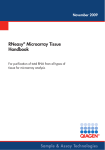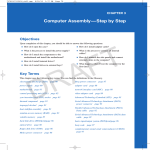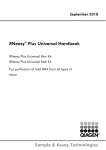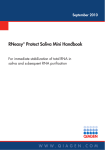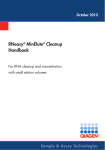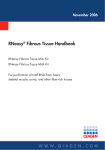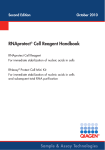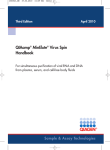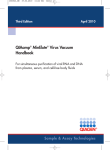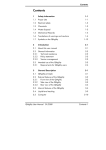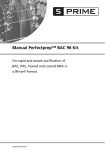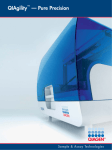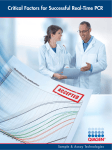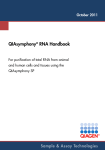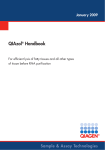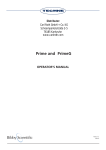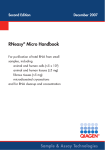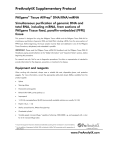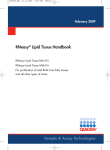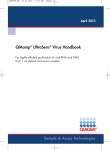Download RNeasy® Protect Animal Blood Handbook
Transcript
1072916_HB_RNeasy_Protect_Animal_Blood_0612.qxp:2012 14.08.2012 18:31 Uhr Seite 1 June 2012 RNeasy® Protect Animal Blood Handbook For purification of total RNA, or total RNA including miRNA, from animal blood stabilized in RNAprotect® Animal Blood Tubes Sample & Assay Technologies 1072916_HB_RNeasy_Protect_Animal_Blood_0612.qxp:2012 14.08.2012 18:31 Uhr Seite 2 QIAGEN Sample and Assay Technologies QIAGEN is the leading provider of innovative sample and assay technologies, enabling the isolation and detection of contents of any biological sample. Our advanced, high-quality products and services ensure success from sample to result. QIAGEN sets standards in: I Purification of DNA, RNA, and proteins I Nucleic acid and protein assays I microRNA research and RNAi I Automation of sample and assay technologies Our mission is to enable you to achieve outstanding success and breakthroughs. For more information, visit www.qiagen.com. 1072916_HB_RNeasy_Protect_Animal_Blood_0612.qxp:2012 14.08.2012 18:31 Uhr Seite 3 Contents Kit Contents 4 Shipping and Storage 5 Intended Use 5 Safety Information 5 Quality Control 6 Introduction 7 Principle and procedure 7 Automated purification 8 Equipment and Reagents to Be Supplied by User Important Notes Collection of starting material 10 11 11 Protocols I I Purification of Total RNA >200 Nucleotides (Excluding miRNA) from RNAprotect Stabilized Animal Blood Purification of Total RNA, Including miRNA, from RNAprotect Stabilized Animal Blood 12 16 Troubleshooting Guide 20 Appendix A: General Remarks on Handling RNA 22 Appendix B: Storage, Quantification, and Determination of Quality of RNA 24 Appendix C: Purification of Small RNAs (<200 nt) from RNAprotect Stabilized Animal Blood 27 Ordering Information 30 RNeasy Protect Animal Blood Handbook 06/2012 3 1072916_HB_RNeasy_Protect_Animal_Blood_0612.qxp:2012 14.08.2012 18:31 Uhr Seite 4 Kit Contents RNeasy Protect Animal Blood Kit (50) Catalog no. 73224 Number of preps 50 ® RNeasy MinElute Spin Columns (pink) (in 2 ml Collection Tubes) 50 QIAshredder Spin Columns (lilac) (in 2 ml Collection Tubes) 50 Collection Tubes (1.5 ml) 150 Collection Tubes (2 ml) 50 Buffer RSB (resuspension buffer) 20 ml Buffer RBT* (binding buffer) 18 ml Buffer RW1* (wash buffer) 45 ml † Buffer RPE (wash buffer concentrate) 11 ml Buffer REB (elution buffer) 5 ml RNase-Free Water 100 ml Proteinase K 1.25 ml RNase-Free DNase Set: I RNase-Free DNase I (lyophilized) I Buffer RDD (DNA digestion buffer) I RNase-Free Water 1500 units 2 x 2 ml 1.5 ml Quick-Start Protocol 1 * Contains a guanidine salt. Not compatible with disinfectants containing bleach. See page 5 for safety information. † Before using for the first time, add 4 volumes of ethanol (96–100%) as indicated on the bottle to obtain a working solution. Note: RNAprotect Animal Blood Tubes are supplied separately. Blood samples must be collected in RNAprotect Animal Blood Tubes. For details, see “Introduction”, page 7. Note: The protocol “Purification of Total RNA, Including miRNA, from RNAprotect Stabilized Animal Blood” requires Buffer RWT (ordered separately; cat. no. 1067933). RNAprotect Animal Blood Tubes Catalog no. 4 (50 x 100 µl) (50 x 500 µl) 76544 76554 RNAprotect Animal Blood Tubes (100 µl) 50 – RNAprotect Animal Blood Tubes (500 µl) – 50 RNeasy Protect Animal Blood Handbook 06/2012 1072916_HB_RNeasy_Protect_Animal_Blood_0612.qxp:2012 14.08.2012 18:31 Uhr Seite 5 Shipping and Storage The RNeasy Protect Animal Blood Kit is shipped at ambient temperature. The RNeasy MinElute spin columns and RNase-Free DNase Set box (containing RNase-free DNase, Buffer RDD, and RNase-free water) should be stored immediately upon receipt at 2–8°C. The remaining components of the kit should be stored dry at room temperature (15–25°C). All kit components are stable for at least 9 months under these conditions. Intended Use The RNeasy Protect Animal Blood Kit is intended for molecular biology applications. This product is not intended for the diagnosis, prevention, or treatment of a disease. All due care and attention should be exercised in the handling of the products. We recommend all users of QIAGEN® products to adhere to the NIH guidelines that have been developed for recombinant DNA experiments, or to other applicable guidelines. Safety Information When working with chemicals, always wear a suitable lab coat, disposable gloves, and protective goggles. For more information, please consult the appropriate safety data sheets (SDSs). These are available online in convenient and compact PDF format at www.qiagen.com/safety where you can find, view, and print the SDS for each QIAGEN kit and kit component. CAUTION: DO NOT add bleach or acidic solutions directly to the sample-preparation waste Buffer RBT contains guanidine thiocyanate and Buffer RW1 contains a small amount of guanidine thiocyanate. Guanidine salts can form highly reactive compounds when combined with bleach. If liquid containing these buffers is spilt, clean with suitable laboratory detergent and water. If the spilt liquid contains potentially infectious agents, clean the affected area first with laboratory detergent and water, and then with 1% (v/v) sodium hypochlorite. 24-hour emergency information Emergency medical information in English, French, and German can be obtained 24 hours a day from: Poison Information Center Mainz, Germany Tel: +49-6131-19240 RNeasy Protect Animal Blood Handbook 06/2012 5 1072916_HB_RNeasy_Protect_Animal_Blood_0612.qxp:2012 14.08.2012 18:31 Uhr Seite 6 Quality Control In accordance with QIAGEN’s ISO-certified Quality Management System, each lot of the RNeasy Protect Animal Blood Kit is tested against predetermined specifications to ensure consistent product quality. 6 RNeasy Protect Animal Blood Handbook 06/2012 1072916_HB_RNeasy_Protect_Animal_Blood_0612.qxp:2012 14.08.2012 18:31 Uhr Seite 7 Introduction The RNeasy Protect Animal Blood System provides a complete solution for stabilization and purification of high-quality RNA from animal blood. Blood from small animals is conveniently collected and stabilized in RNAprotect Animal Blood Tubes. Total RNA is then purified using the RNeasy Protect Animal Blood Kit. To obtain microRNA (miRNA), either in a total RNA fraction or in a small RNA fraction, please refer to the protocol “Purification of Total RNA, Including miRNA, from RNAprotect Stabilized Animal Blood” on page 16. The system has been developed for and tested with blood from rats and mice. Performance with blood from other species may vary. The purified total RNA is ready to use and is highly suited for any downstream application, including: I RT-PCR and real-time RT-PCR I Differential display I cDNA synthesis I Northern, dot, and slot blot analyses I Primer extension I Poly A+ RNA selection I RNase/S1 nuclease protection I Microarrays The RNeasy Protect Animal Blood Kit allow parallel processing of multiple samples in less than 80 minutes (including hands-on time of 30 minutes). Methods involving the use of toxic substances such as phenol and/or chloroform, or time-consuming and tedious methods such as alcohol precipitation, are replaced by the RNeasy/miRNeasy procedure. Important: To ensure optimal performance of theRNeasy Protect Animal Blood Kit, blood samples must be collected in RNAprotect Animal Blood Tubes. The tubes are not included in the kits and are supplied separately in 2 sizes: RNAprotect Animal Blood Tubes (100 µl) for 100 µl blood, and RNAprotect Animal Blood Tubes (500 µl) for 500 µl blood. For ordering information, see page 30. Important: Buffer RWT must be ordered separately (see ordering information, page 30) for use when following the protocol “Purification of Total RNA, Including miRNA, from RNAprotect Stabilized Animal Blood”, page 16. Principle and procedure Blood samples are collected in RNAprotect Animal Blood Tubes, which contain a reagent that lyses blood cells and immediately stabilizes intracellular RNA to preserve the gene expression profile. RNA stabilization is critical for reliable downstream gene expression analysis, as degradation of RNA and upregulation or downregulation of transcripts RNeasy Protect Animal Blood Handbook 06/2012 7 1072916_HB_RNeasy_Protect_Animal_Blood_0612.qxp:2012 14.08.2012 18:31 Uhr Seite 8 occur straightaway after blood is drawn from the animal. Blood samples collected in RNAprotect Animal Blood Tubes can be safely stored or transported at 15–25°C for up to 48 hours, at 2–8°C for up to 2 weeks, or at –20°C for at least 3 months without showing any significant RNA degradation or changes in transcript levels. Total RNA is purified from the stabilized blood samples using well-established RNeasy silica-membrane technology. RNAprotect Animal Blood Tubes are first centrifuged to pellet the samples, which are then washed with water and resuspended in Buffer RSB. After digestion in Buffer RBT with proteinase K, the samples are homogenized by centrifugation in QIAshredder spin columns. Ethanol is added to the samples to optimize binding conditions, and the samples are then centrifuged in RNeasy MinElute spin columns, where total RNA binds to the RNeasy MinElute silica membrane. The total RNA that is bound to the membrane is subjected to DNase digestion to remove genomic DNA contamination, and washed with Buffer RW1 (RNeasy Kit) or Buffer RWT (ordered separately) followed by Buffer RPE. Pure RNA is then eluted in Buffer REB. When following the protocol “Purification of Total RNA, Including miRNA, from RNAprotect Stabilized Animal Blood”, all RNA molecules longer than 200 nucleotides are purified (see protocol on page 16). This is an enrichment procedure for mRNA, since most RNAs <200 nucleotides (such as miRNA, 5.8S rRNA, 5S rRNA, and tRNAs, which together make up 15–20% of total RNA) are selectively excluded. When following the protocol “Purification of Total RNA, Including miRNA, from RNAprotect Stabilized Animal Blood”, all RNA molecules longer than approximately 18 nucleotides are purified (see protocol on page 16). The purified RNA includes both mRNA and small RNAs such as miRNA. Alternatively, the RNeasy Protect Animal Blood Kit can be used in combination with the RNeasy MinElute Cleanup Kit to purify a small RNA fraction containing miRNA and other RNAs shorter than 200 nucleotides (see Appendix C, page 27). Automated purification Purification of RNA can be fully automated on the QIAcube®. The innovative QIAcube uses advanced technology to process QIAGEN spin columns, enabling seamless integration of automated, low-throughput sample prep into your laboratory workflow. Sample preparation using the QIAcube follows the same steps as the manual procedure (i.e., lyse, bind, wash, and elute), enabling you to continue using RNeasy Protect Animal Blood Kits for purification of high-quality RNA. For more information about the automated procedure, see the relevant protocol sheet available at www.qiagen.com/MyQIAcube. The QIAcube is preinstalled with protocols for purification of plasmid DNA, genomic DNA, RNA, viral nucleic acids, and proteins, plus DNA and RNA cleanup. The range of protocols available is continually expanding, and additional QIAGEN protocols can be downloaded free of charge at www.qiagen.com/MyQIAcube. 8 RNeasy Protect Animal Blood Handbook 06/2012 1072916_HB_RNeasy_Protect_Animal_Blood_0612.qxp:2012 14.08.2012 18:31 Uhr Seite 9 RNeasy Protect Animal Blood Procedure Animal blood collected in RNAprotect Animal Blood Tubes Wash blood pellet with water, and then resuspend in Buffer RSB Digest in Buffer RBT with proteinase K Homogenize by centrifugation in QIAshredder column, and then add ethanol Bind RNA to RNeasy MinElute column, and then digest DNA Total RNA Wash with Buffer RW1* and Buffer RPE Wash with Buffer RWT† and Buffer RPE Elute with Buffer REB Elute with Buffer REB Total RNA >200 nt Total RNA, including miRNA * Included in RNeasy Protect Animal Blood Kit. † Ordered separately. Refer to ordering information on page 30. RNeasy Protect Animal Blood Handbook 06/2012 9 1072916_HB_RNeasy_Protect_Animal_Blood_0612.qxp:2012 14.08.2012 18:31 Uhr Seite 10 Equipment and Reagents to Be Supplied by User When working with chemicals, always wear a suitable lab coat, disposable gloves, and protective goggles. For more information, consult the appropriate safety data sheets (SDSs), available from the product supplier. I For 100 µl blood samples: RNAprotect Animal Blood Tubes (50 x 100 µl) (cat. no. 76544) I For 500 µl blood samples: RNAprotect Animal Blood Tubes (50 x 500 µl) (cat. no. 76554) I Ethanol (96–100% and 80%)* I Ethanol (100%)† I Sterile, RNase-free pipet tips I Microcentrifuge tubes (1.5 ml) I Ice I Microcentrifuge (with rotor for 2 ml tubes) I Shaker–incubator capable of incubating at 55°C and 65°C and shaking at 400 rpm, but not exceeding 1400 rpm (e.g., Eppendorf® Thermomixer Compact‡ or equivalent) I Vortexer I If using the protocol “Purification of Total RNA, Including miRNA, from RNAprotect Stabilized Animal Blood”: Buffer RWT (concentrate, 80 ml) (cat. no. 1067933) * Do not use denatured alcohol, which contains other substances such as methanol or methylethylketone. † If using the protocol “Purification of Total RNA, Including miRNA, from RNAprotect Stabilized Animal Blood”. ‡ This is not a complete list of suppliers and does not include many important vendors of biological supplies. 10 RNeasy Protect Animal Blood Handbook 06/2012 1072916_HB_RNeasy_Protect_Animal_Blood_0612.qxp:2012 14.08.2012 18:31 Uhr Important Notes Collection of starting material Before using the RNeasy Protect Animal Blood Kit, it is important to collect blood samples as described in the product sheet supplied with RNAprotect Animal Blood Tubes (see ordering information, page 30). The kits are designed specifically for use with animal (rat and mouse) blood collected in RNAprotect Animal Blood Tubes. The kits should not be used with unstabilized blood or with blood stabilized by other methods. When collecting blood with RNAprotect Animal Blood Tubes, be sure to collect the specified volume of blood (i.e., 100 µl or 500 µl). Collection of larger or smaller volumes of blood may lead to incomplete RNA stabilization, and RNA yields may be significantly lower than expected. The specifications of the RNeasy MinElute spin column and the typical yields of total RNA that can be achieved with it are shown in Tables 1 and 2. Table 1. RNeasy MinElute spin column specifications Maximum binding capacity Maximum loading volume 45 µg RNA 700 µl Minimum elution volume 14 µl Table 2. Typical yields of total RNA with RNeasy Protect Animal Blood Kits Sample type Rat blood (500 µl) Mouse blood (100 µl) Yield of total RNA* (µg) 10–30 4–8 * Amounts can vary due to factors such as species, age, and health of the animal. Since the RNeasy Protect Animal Blood Kit enriches for mRNA and other RNA species >200 nucleotides, the total RNA yield obtained with this kit does not include miRNA, 5S rRNA, tRNA, and other low-molecular-weight RNAs, which make up 15–20% of total cellular RNA. To purify RNA species smaller than 200 nt, follow the protocol “Purification of Total RNA, Including miRNA, from RNAprotect Stabilized Animal Blood” on page 16 of the handbook. RNeasy Protect Animal Blood Handbook 06/2012 11 Seite 11 Total RNA 1072916_HB_RNeasy_Protect_Animal_Blood_0612.qxp:2012 14.08.2012 18:31 Uhr Seite 12 Protocol: Purification of Total RNA >200 Nucleotides (Excluding miRNA) from RNAprotect Stabilized Animal Blood This protocol is for purification of total RNA that excludes small RNAs such as miRNA, and requires the RNeasy Protect Animal Blood Kit. The protocol is for use with blood samples collected in RNAprotect Animal Blood Tubes. It is important to collect blood as described in the product sheet supplied with RNAprotect Animal Blood Tubes. If transporting the tubes, be sure to handle the tubes according to the recommendations in the product sheet. Important points before starting I If using the RNeasy Protect Animal Blood Kit for the first time, read “Safety Information” (page 5) and “Important Notes” (page 11). I If preparing RNA for the first time, read Appendix A (page 22). I Buffer RBT and Buffer RW1 contain a guanidine salt and are therefore not compatible with disinfecting reagents containing bleach. See page 5 for safety information. I Unless otherwise indicated, perform all steps of the procedure at room temperature (15–25°C). During the procedure, work quickly. I If using a refrigerated microcentrifuge, make sure cooling is switched off (i.e., set the temperature to just above ambient temperature). Make sure the microcentrifuge is at room temperature. Things to do before starting I Ensure that RNAprotect Animal Blood Tubes are incubated for at least 2 h at room temperature (15–25°C) after blood collection to ensure complete lysis of blood cells. Incubating the tubes overnight may increase RNA yields. If the tubes were stored at 2–8°C or below directly after blood collection, first equilibrate the tubes to room temperature, and then store at room temperature for 2 h before starting the procedure. I Buffer RPE is supplied as a concentrate. Before using for the first time, add 4 volumes of ethanol (96–100%) as indicated on the bottle to obtain a working solution. I Buffer RBT may form a precipitate during storage. If necessary, redissolve by warming at 37°C, and then place at room temperature. I If using the RNase-Free DNase Set for the first time, prepare DNase I stock solution. Dissolve the lyophilized DNase I (1500 Kunitz units) in 550 µl of the RNase-free water provided with the set. To avoid loss of DNase I, do not open the vial. Inject RNase-free water into the vial using an RNase-free needle and syringe. Mix gently by inverting the vial. Do not vortex. 12 RNeasy Protect Animal Blood Handbook 06/2012 1072916_HB_RNeasy_Protect_Animal_Blood_0612.qxp:2012 14.08.2012 18:31 Uhr Procedure 1. Centrifuge the RNAprotect Animal Blood Tube for 3 min at 5000 x g. Note: Be sure to incubate the tube for at least 2 h at room temperature (15–25°C) after blood collection to achieve complete lysis of blood cells. Note: If using an RNAprotect Animal Blood Tube (100 µl), transfer the blood sample to a new 1.5 ml collection tube (supplied; the same tube can be used in step 5). Alternatively, use only 450 µl RNase-free water in step 2 below. 2. Remove the supernatant by decanting or pipetting. Add 1 ml RNase-free water to the pellet, and close the tube. If decanting the supernatant, take care not to disturb the pellet, and dry the rim of the tube with a clean paper towel. 3. Vortex until the pellet is visibly dissolved, and centrifuge for 3 min at 5000 x g. Remove the entire supernatant by decanting or pipetting, and discard. Small debris remaining in the sample after vortexing does not affect subsequent RNA purification. Note: Incomplete removal of the supernatant will inhibit proteinase K digestion and dilute the lysate, affecting the conditions for binding RNA to the RNeasy MinElute membrane. 4. Add 240 µl Buffer RSB and vortex until the pellet is visibly dissolved. 5. Pipet the sample into a 1.5 ml collection tube (supplied). Add 200 µl Buffer RBT and 20 µl proteinase K. Mix by vortexing for 5 s and incubate for 10 min at 55°C in a shaker–incubator at 400–1400 rpm. After incubation, set the temperature of the shaker–incubator to 65°C for step 18. Note: Do not mix Buffer RBT and proteinase K together before adding them to the sample. 6. Pipet the sample into a QIAshredder spin column (lilac) placed in a 2 ml collection tube, and centrifuge for 3 min at full speed (do not exceed 20,000 x g). 7. Carefully transfer the entire supernatant of the flow-through from the QIAshredder spin column to a new 1.5 ml collection tube (supplied) without disturbing the pellet. 8. Add 240 µl ethanol (96–100%) and mix by vortexing. RNeasy Protect Animal Blood Handbook 06/2012 13 Total RNA For long-term storage of DNase I, remove the stock solution from the glass vial, divide it into single-use aliquots, and store at –20°C for up to 9 months. Thawed aliquots can be stored at 2–8°C for up to 6 weeks. Do not refreeze the aliquots after thawing. Seite 13 1072916_HB_RNeasy_Protect_Animal_Blood_0612.qxp:2012 Total RNA 9. 14.08.2012 18:31 Uhr Seite 14 Pipet the sample into an RNeasy MinElute spin column (pink) placed in a 2 ml collection tube. Close the lid gently, and centrifuge for 1 min at ≥8000 x g (≥10,000 rpm). Discard the flow-through.* Reuse the collection tube in step 10. 10. Add 350 µl Buffer RW1 to the RNeasy MinElute spin column. Close the lid gently, and centrifuge for 15 s at ≥8000 x g (≥10,000 rpm). Discard the flow-through.* Reuse the collection tube in step 13. Note: After centrifugation, carefully remove the RNeasy MinElute spin column from the collection tube so that the column does not contact the flow-through. Be sure to empty the collection tube completely. 11. Add 10 µl DNase I stock solution to 70 µl Buffer RDD in a 1.5 ml microcentrifuge tube (not supplied). Mix by gently inverting the tube, and centrifuge briefly to collect residual liquid from the sides of the tube. Note: DNase I is especially sensitive to physical denaturation. Mixing should only be carried out by gently inverting the tube. Do not vortex. 12. Pipet the DNase I incubation mix (80 µl) directly onto the RNeasy MinElute spin column membrane, and incubate on the benchtop (20–30°C) for 15 min. Note: Be sure to add the DNase I incubation mix directly to the spin column membrane. DNase digestion will be incomplete if part of the mix sticks to the walls or the O-ring of the spin column. 13. Add 350 µl Buffer RW1 to the RNeasy MinElute spin column. Close the lid gently, and centrifuge for 15 s at ≥8000 x g (≥10,000 rpm). Discard the flow-through.* Reuse the collection tube in step 14. Note: After centrifugation, carefully remove the RNeasy MinElute spin column from the collection tube so that the column does not contact the flow-through. Be sure to empty the collection tube completely. 14. Add 500 µl Buffer RPE to the RNeasy MinElute spin column. Close the lid gently, and centrifuge for 15 s at ≥8000 x g (≥10,000 rpm). Discard the flow-through. Reuse the collection tube in step 15. Note: Buffer RPE is supplied as a concentrate. Ensure that ethanol is added to Buffer RPE before use (see “Things to do before starting”). 15. Add 500 µl of 80% ethanol to the RNeasy MinElute spin column. Close the lid gently and centrifuge for 2 min at ≥8000 x g (≥10,000 rpm). Note: After centrifugation, carefully remove the RNeasy MinElute spin column from the collection tube so that the column does not contact the flow-through. Otherwise, carryover of ethanol will occur. * Flow-through contains Buffer RBT or Buffer RW1 and is therefore not compatible with bleach. See page 5 for safety information. 14 RNeasy Protect Animal Blood Handbook 06/2012 1072916_HB_RNeasy_Protect_Animal_Blood_0612.qxp:2012 14.08.2012 18:31 Uhr Seite 15 16. Place the RNeasy MinElute spin column in a new 2 ml collection tube (supplied). Open the lid of the spin column and centrifuge at full speed for 5 min. Discard the flow-through and collection tube. It is important to dry the spin column membrane, since residual ethanol may interfere with downstream reactions. Centrifugation with the lids open ensures that no ethanol is carried over during RNA elution. 17. Place the RNeasy MinElute spin column in a new 1.5 ml collection tube, and pipet 14–30 µl Buffer REB directly onto the spin column membrane. Close the lid gently and centrifuge for 1 min at ≥8000 x g (≥10,000 rpm) to elute the RNA. Be sure to add Buffer REB directly to the spin column membrane. This wets the entire membrane, ensuring maximum elution efficiency. 18. Incubate the RNA eluate for 5 min at 65°C in the shaker–incubator without shaking. After incubation, chill immediately on ice. This incubation at 65°C denatures the RNA for downstream applications. Do not exceed the incubation time or temperature. 19. If the RNA eluate will not be used immediately, store at –20°C or –70°C. Since the RNA remains denatured after freezing and thawing, it is not necessary to repeat the incubation at 65°C. Note: If quantifying the RNA using a spectrophotometer, refer to the guidelines in Appendix B (page 24). Buffer REB shows high absorbance at 220 nm, which can lead to high background absorbance levels if the spectrophotometer is not properly zeroed. For RT-PCR and real-time RT-PCR with the purified RNA, QIAGEN offers a range of optimized, ready-to-use kits that provide highly specific and sensitive results. For details, visit www.qiagen.com/PCR. RNeasy Protect Animal Blood Handbook 06/2012 15 Total RNA To avoid damage to their lids, place the spin columns into the centrifuge with at least one empty position between columns. Orient the lids so that they point in a direction opposite to the rotation of the rotor (e.g., if the rotor rotates clockwise, orient the lids counterclockwise). 1072916_HB_RNeasy_Protect_Animal_Blood_0612.qxp:2012 14.08.2012 18:31 Uhr Seite 16 Total RNA Including miRNA Protocol: Purification of Total RNA, Including miRNA, from RNAprotect Stabilized Animal Blood This protocol is for purification of total RNA that includes miRNA and other small RNAs (e.g., tRNA), and requires the RNeasy Protect Animal Blood Kit and Buffer RWT (ordered separately). The protocol is for use with blood samples collected in RNAprotect Animal Blood Tubes. It is important to collect blood as described in the product sheet supplied with RNAprotect Animal Blood Tubes. If transporting the tubes, be sure to handle the tubes according to the recommendations in the product sheet. Important points before starting I If using the RNeasy Protect Animal Blood Kit for the first time, read “Safety Information” (page 5) and “Important Notes” (page 11). I It is essential to use Buffer RWT (ordered separately) for steps 10 and 13 of the protocol. Do not use Buffer RW1 for these steps. I If preparing RNA for the first time, read Appendix A (page 22). I Buffer RBT and Buffer RWT contain a guanidine salt and are therefore not compatible with disinfecting reagents containing bleach. See page 5 for safety information. I Unless otherwise indicated, perform all steps of the procedure at room temperature (15–25°C). During the procedure, work quickly. I If using a refrigerated microcentrifuge, make sure cooling is switched off (i.e., set the temperature to just above ambient temperature). Make sure the microcentrifuge is at room temperature. Things to do before starting I Ensure that RNAprotect Animal Blood Tubes are incubated for at least 2 h at room temperature (15–25°C) after blood collection to ensure complete lysis of blood cells. Incubating the tubes overnight may increase RNA yields. If the tubes were stored at 2–8°C or below directly after blood collection, first equilibrate the tubes to room temperature, and then store at room temperature for 2 h before starting the procedure. I Buffers RWT and RPE are supplied as concentrates. Before using for the first time, add the required volume of ethanol (96–100%) as indicated on the bottle to obtain a working solution. I Buffer RBT may form a precipitate during storage. If necessary, redissolve by warming at 37°C, and then place at room temperature. I If using the RNase-Free DNase Set for the first time, prepare DNase I stock solution. Dissolve the lyophilized DNase I (1500 Kunitz units) in 550 µl of the RNase-free water provided with the set. To avoid loss of DNase I, do not open the vial. Inject RNase-free water into the vial using an RNase-free needle and syringe. Mix gently by inverting the vial. Do not vortex. 16 RNeasy Protect Animal Blood Handbook 06/2012 1072916_HB_RNeasy_Protect_Animal_Blood_0612.qxp:2012 14.08.2012 18:31 Uhr Seite 17 For long-term storage of DNase I, remove the stock solution from the glass vial, divide it into single-use aliquots, and store at –20°C for up to 9 months. Thawed aliquots can be stored at 2–8°C for up to 6 weeks. Do not refreeze the aliquots after thawing. Procedure 1. Centrifuge the RNAprotect Animal Blood Tube for 3 min at 5000 x g. Note: If using an RNAprotect Animal Blood Tube (100 µl), transfer the blood sample to a new 1.5 ml collection tube (supplied; the same tube can be used in step 5). Alternatively, use only 450 µl RNase-free water in step 2 below. 2. Remove the supernatant by decanting or pipetting. Add 1 ml RNase-free water to the pellet, and close the tube. If decanting the supernatant, take care not to disturb the pellet, and dry the rim of the tube with a clean paper towel. 3. Vortex until the pellet is visibly dissolved and centrifuge for 3 min at 5000 x g. Remove the entire supernatant by decanting or pipetting, and discard. Small debris remaining in the sample after vortexing does not affect subsequent RNA purification. Note: Incomplete removal of the supernatant will inhibit proteinase K digestion and dilute the lysate, affecting the conditions for binding RNA to the RNeasy MinElute membrane. 4. Add 240 µl Buffer RSB, and vortex until the pellet is visibly dissolved. 5. Pipet the sample into a 1.5 ml collection tube (supplied). Add 200 µl Buffer RBT and 20 µl proteinase K. Mix by vortexing for 5 s, and incubate for 10 min at 55°C in a shaker–incubator at 400–1400 rpm. After incubation, set the temperature of the shaker–incubator to 65°C for step 18. Note: Do not mix Buffer RBT and proteinase K together before adding them to the sample. 6. Pipet the sample into a QIAshredder spin column (lilac) placed in a 2 ml collection tube, and centrifuge for 3 min at full speed (do not exceed 20,000 x g). 7. Carefully transfer the entire supernatant of the flow-through from the QIAshredder spin column to a new 1.5 ml collection tube (supplied) without disturbing the pellet. 8. Add 1.5 volumes (usually 690 µl) of 100% ethanol, and mix by vortexing. RNeasy Protect Animal Blood Handbook 06/2012 17 Total RNA Including miRNA Note: Be sure to incubate the tube for at least 2 h at room temperature (15–25°C) after blood collection to achieve complete lysis of blood cells. 1072916_HB_RNeasy_Protect_Animal_Blood_0612.qxp:2012 9. 14.08.2012 18:31 Uhr Seite 18 Pipet 700 µl sample into an RNeasy MinElute spin column (pink) placed in a 2 ml collection tube. Close the lid gently and centrifuge for 1 min at ≥8000 x g (≥10,000 rpm). Discard the flow-through.* Transfer the remaining sample, repeat the centrifugation, and discard the flow-through.* Reuse the collection tube in step 10. Total RNA Including miRNA 10. Add 350 µl Buffer RWT to the RNeasy MinElute spin column. Close the lid gently, and centrifuge for 15 s at ≥8000 x g (≥10,000 rpm). Discard the flow-through.* Reuse the collection tube in step 13. Note: Buffer RWT is supplied as a concentrate. Ensure that ethanol is added to Buffer RWT before use (see “Things to do before starting”). Note: It is essential to use Buffer RWT. Do not use Buffer RW1 and do not omit this washing step. Note: After centrifugation, carefully remove the RNeasy MinElute spin column from the collection tube so that the column does not contact the flow-through. Be sure to empty the collection tube completely. 11. Add 10 µl DNase I stock solution to 70 µl Buffer RDD in a 1.5 ml microcentrifuge tube (not supplied). Mix by gently inverting the tube and centrifuge briefly to collect residual liquid from the sides of the tube. Note: DNase I is especially sensitive to physical denaturation. Mixing should only be carried out by gently inverting the tube. Do not vortex. 12. Pipet the DNase I incubation mix (80 µl) directly onto the RNeasy MinElute spin column membrane, and incubate on the benchtop (20–30°C) for 15 min. Note: Be sure to add the DNase I incubation mix directly to the spin column membrane. DNase digestion will be incomplete if part of the mix sticks to the walls or the O-ring of the spin column. 13. Add 350 µl Buffer RWT to the RNeasy MinElute spin column. Close the lid gently, and centrifuge for 15 s at ≥8000 x g (≥10,000 rpm). Discard the flow-through.* Reuse the collection tube in step 14. Note: It is essential to use Buffer RWT. Do not use Buffer RW1 and do not omit this washing step. Note: After centrifugation, carefully remove the RNeasy MinElute spin column from the collection tube so that the column does not contact the flow-through. Be sure to empty the collection tube completely. * Flow-through contains Buffer RBT or Buffer RWT and is therefore not compatible with bleach. See page 5 for safety information. 18 RNeasy Protect Animal Blood Handbook 06/2012 1072916_HB_RNeasy_Protect_Animal_Blood_0612.qxp:2012 14.08.2012 18:31 Uhr Seite 19 14. Add 500 µl Buffer RPE to the RNeasy MinElute spin column. Close the lid gently, and centrifuge for 15 s at ≥8000 x g (≥10,000 rpm). Discard the flow-through. Reuse the collection tube in step 15. Note: Buffer RPE is supplied as a concentrate. Ensure that ethanol is added to Buffer RPE before use (see “Things to do before starting”). 15. Add 500 µl of 80% ethanol to the RNeasy MinElute spin column. Close the lid gently, and centrifuge for 2 min at ≥8000 x g (≥10,000 rpm). 16. Place the RNeasy MinElute spin column in a new 2 ml collection tube (supplied). Open the lid of the spin column and centrifuge at full speed for 5 min. Discard the flow-through and collection tube. To avoid damage to their lids, place the spin columns into the centrifuge with at least one empty position between columns. Orient the lids so that they point in a direction opposite to the rotation of the rotor (e.g., if the rotor rotates clockwise, orient the lids counterclockwise). It is important to dry the spin column membrane, since residual ethanol may interfere with downstream reactions. Centrifugation with the lids open ensures that no ethanol is carried over during RNA elution. 17. Place the RNeasy MinElute spin column in a new 1.5 ml collection tube, and pipet 14–30 µl Buffer REB directly onto the spin column membrane. Close the lid gently, and centrifuge for 1 min at ≥8000 x g (≥10,000 rpm) to elute the RNA. Be sure to add Buffer REB directly to the spin column membrane. This wets the entire membrane, ensuring maximum elution efficiency. 18. Incubate the RNA eluate for 5 min at 65°C in the shaker–incubator without shaking. After incubation, chill immediately on ice. This incubation at 65°C denatures the RNA for downstream applications. Do not exceed the incubation time or temperature. 19. If the RNA eluate will not be used immediately, store at –20°C or –70°C. Since the RNA remains denatured after freezing and thawing, it is not necessary to repeat the incubation at 65°C. Note: If quantifying the RNA using a spectrophotometer, refer to the guidelines in Appendix B (page 24). Buffer REB shows high absorbance at 220 nm, which can lead to high background absorbance levels if the spectrophotometer is not properly zeroed. For RT-PCR and real-time RT-PCR with the purified RNA, QIAGEN offers a range of optimized, ready-to-use kits that provide highly specific and sensitive results. For details, visit www.qiagen.com/PCR and www.qiagen.com/miRNA. RNeasy Protect Animal Blood Handbook 06/2012 19 Total RNA Including miRNA Note: After centrifugation, carefully remove the RNeasy MinElute spin column from the collection tube so that the column does not contact the flow-through. Otherwise, carryover of ethanol will occur. 1072916_HB_RNeasy_Protect_Animal_Blood_0612.qxp:2012 14.08.2012 18:31 Uhr Seite 20 Troubleshooting Guide This troubleshooting guide may be helpful in solving any problems that may arise. For more information, see also the Frequently Asked Questions page at our Technical Support Center: www.qiagen.com/FAQ/FAQList.aspx. The scientists in QIAGEN Technical Services are always happy to answer any questions you may have about either the information and protocols in this handbook or sample and assay technologies (for contact information, see back cover or visit www.qiagen.com). Comments and suggestions Low RNA yield a) Insufficient blood collected in RNAprotect Animal Blood Tube If using RNAprotect Animal Blood Tubes (100 µl), do not collect less than the 100 µl blood. If using RNAprotect Animal Blood Tubes (500 µl), do not collect less than the 500 µl blood. b) RNA diluted in water for A260 measurement For accurate quantification, RNA must be diluted in 10 mM Tris·Cl, pH 7.0 (see Appendix B, page 24). c) RNA still bound to RNeasy MinElute spin column membrane Repeat RNA elution, but incubate the RNeasy MinElute spin column on the benchtop for 10 min with Buffer REB before centrifuging. d) Cell debris transferred to RNeasy MinElute spin column Be sure to vortex the pellet at step 3 of the protocol (however, the presence of small debris does not affect the procedure). e) Supernatant not completely Be sure to remove the entire supernatant. If removed after centrifuging decanting the supernatant, remove drops from RNAprotect Animal Blood Tube the rim of the tube by dabbing onto a paper towel. f) Blood incubated for less than 2 h in RNAprotect Animal Blood Tubes After collecting blood in RNAprotect Animal Blood Tubes, be sure to incubate for at least 2 h at room temperature (15–25°C). g) RNeasy MinElute spin columns incorrectly stored Store RNeasy MinElute spin columns at 2–8°C. Low A260/A280 value Water used to dilute RNA for A260/A280 measurement 20 Use 10 mM Tris·Cl, pH 7.5, not RNase-free water, to dilute the sample before measuring purity (see Appendix B, page 24) RNeasy Protect Animal Blood Handbook 06/2012 1072916_HB_RNeasy_Protect_Animal_Blood_0612.qxp:2012 14.08.2012 18:31 Uhr Comments and suggestions RNA degraded RNase contamination Although all RNeasy buffers have been tested and are guaranteed RNase-free, RNases can be introduced during use. Be certain not to introduce any RNases during the RNeasy procedure or later handling. See Appendix A (page 22) for general remarks on handling RNA. Do not put RNA samples into a vacuum dryer or microcentrifuge that has been used in DNA preparation where RNases may have been used. RNA does not perform well in downstream experiments High levels of globin mRNA affect microarray analysis High levels of globin mRNA in purified RNA from whole blood reduce the sensitivity of gene expression analysis with Affymetrix® GeneChip® arrays. To avoid this problem, we recommend preparing targets for GeneChip arrays using the Ovation® Whole Blood Solution from NuGEN (www.nugeninc.com). RNeasy Protect Animal Blood Handbook 06/2012 21 Seite 21 1072916_HB_RNeasy_Protect_Animal_Blood_0612.qxp:2012 14.08.2012 18:31 Uhr Seite 22 Appendix A: General Remarks on Handling RNA Handling RNA Ribonucleases (RNases) are very stable and active enzymes that generally do not require cofactors to function. Since RNases are difficult to inactivate and even minute amounts are sufficient to destroy RNA, do not use any plasticware or glassware without first eliminating possible RNase contamination. Care should be taken to avoid inadvertently introducing RNases into the RNA sample during or after the purification procedure. To create and maintain an RNase-free environment, the following precautions must be taken during pretreatment and use of disposable and nondisposable vessels and solutions while working with RNA. General handling Proper microbiological, aseptic technique should always be used when working with RNA. Hands and dust particles may carry bacteria and molds and are the most common sources of RNase contamination. Always wear latex or vinyl gloves while handling reagents and RNA samples to prevent RNase contamination from the surface of the skin or from dusty laboratory equipment. Change gloves frequently and keep tubes closed whenever possible. Keep purified RNA on ice when aliquots are pipetted for downstream applications. To remove RNase contamination from bench surfaces, nondisposable plasticware, and laboratory equipment (e.g., pipets and electrophoresis tanks), use of RNaseKiller (cat. no. 2500080) from 5 PRIME (www.5prime.com) is recommended. RNase contamination can alternatively be removed using general laboratory reagents. To decontaminate plasticware, rinse with 0.1 M NaOH, 1 mM EDTA* followed by RNase-free water (see “Solutions”, page 23) or rinse with chloroform* if the plasticware is chloroform-resistant. To decontaminate electrophoresis tanks, clean with detergent (e.g., 0.5% SDS),* rinse with RNase-free water, rinse with ethanol (if the tanks are ethanol-resistant), and allow to dry. Disposable plasticware The use of sterile, disposable polypropylene tubes is recommended throughout the procedure. These tubes are generally RNase-free and do not require pretreatment to inactivate RNases. * When working with chemicals, always wear a suitable lab coat, disposable gloves, and protective goggles. For more information, consult the appropriate safety data sheets (SDSs), available from the product supplier. 22 RNeasy Protect Animal Blood Handbook 06/2012 1072916_HB_RNeasy_Protect_Animal_Blood_0612.qxp:2012 14.08.2012 18:31 Uhr Glassware Glassware should be treated before use to ensure that it is RNase-free. Glassware used for RNA work should be cleaned with a detergent,* thoroughly rinsed, and oven baked at 240°C for at least 4 hours (overnight, if more convenient) before use. Autoclaving alone will not fully inactivate many RNases. Alternatively, glassware can be treated with DEPC* (diethyl pyrocarbonate) as described in “Solutions” below. Solutions Note: QIAGEN solutions, such as RNeasy buffers, are guaranteed RNase-free without using DEPC treatment, and are therefore free of any DEPC contamination. Solutions (water and other solutions) should be treated with 0.1% DEPC. DEPC is a strong, but not absolute, inhibitor of RNases. It is commonly used at a concentration of 0.1% to inactivate RNases on glass or plasticware or to create RNase-free solutions and water. DEPC inactivates RNases by covalent modification. Add 0.1 ml DEPC to 100 ml of the solution to be treated and shake vigorously to bring the DEPC into solution. Let the solution incubate for 12 hours at 37°C. Autoclave for 15 minutes to remove any trace of DEPC. DEPC will react with primary amines and cannot be used directly to treat Tris* buffers. DEPC is highly unstable in the presence of Tris buffers and decomposes rapidly into ethanol and CO2. When preparing Tris buffers, treat water with DEPC first, and then dissolve Tris to make the appropriate buffer. Trace amounts of DEPC will modify purine residues in RNA by carbethoxylation. Carbethoxylated RNA is translated with very low efficiency in cell-free systems. However, its ability to form DNA:RNA or RNA:RNA hybrids is not seriously affected unless a large fraction of the purine residues have been modified. Residual DEPC must always be eliminated from solutions or vessels by autoclaving or heating to 100°C for 15 minutes. * When working with chemicals, always wear a suitable lab coat, disposable gloves, and protective goggles. For more information, consult the appropriate safety data sheets (SDSs), available from the product supplier. RNeasy Protect Animal Blood Handbook 06/2012 23 Seite 23 1072916_HB_RNeasy_Protect_Animal_Blood_0612.qxp:2012 14.08.2012 18:31 Uhr Seite 24 Appendix B: Storage, Quantification, and Determination of Quality of RNA Storage of RNA Purified RNA may be stored at –20°C or –70°C in Buffer REB. Under these conditions, no degradation of RNA is detectable after 1 year. Quantification of RNA The concentration of RNA can be determined by measuring the absorbance at 260 nm (A260) in a spectrophotometer (see “Spectrophotometric quantification of RNA” below). For small amounts of RNA, however, it may not be possible to accurately determine amounts photometrically. Small amounts of RNA can be quantified using the QIAxcel® Advanced system (www.qiagen.com/QIAxcel) or Agilent® 2100 bioanalyzer, fluorometric quantification, or quantitative, real-time RT-PCR. Spectrophotometric quantification of RNA To ensure significance, A260 readings should be greater than 0.15. An absorbance of 1 unit at 260 nm corresponds to 44 µg of RNA per ml (A260=1 → 44 µg/ml). This relation is valid only for measurements at a neutral pH. Therefore, if it is necessary to dilute the RNA sample, this should be done in a buffer with neutral pH.* As discussed below (see “Purity of RNA”, page 25), the ratio between the absorbance values at 260 and 280 nm gives an estimate of RNA purity. When measuring RNA samples, be certain that cuvettes are RNase-free, especially if the RNA is to be recovered after spectrophotometry. This can be accomplished by washing cuvettes with 0.1 M NaOH, 1 mM EDTA,* followed by washing with RNase-free water (see “Solutions”, page 23). When zeroing the spectrophotometer, be sure to use a solution that contains Buffer REB at the same dilution as the RNA solution to be quantified. An example of the calculation involved in RNA quantification is shown below: Volume of RNA sample = 10 µl Dilution = 1 µl of RNA sample + 499 µl of 10 mM Tris·Cl,* pH 7.0 (1/500 dilution)† Measure absorbance of diluted sample in a 1 ml cuvette (RNase-free) A260 = 0.2 * When working with chemicals, always wear a suitable lab coat, disposable gloves, and protective goggles. For more information, consult the appropriate safety data sheets (SDSs), available from the product supplier. † In addition, dilute 1 µl Buffer REB with 499 µl of 10 mM Tris·Cl, pH 7.0, and use this to zero the spectrophotometer. 24 RNeasy Protect Animal Blood Handbook 06/2012 1072916_HB_RNeasy_Protect_Animal_Blood_0612.qxp:2012 Concentration of RNA sample 14.08.2012 18:31 Uhr = 44 µg/ml x A260 x dilution factor = 44 µg/ml x 0.2 x 500 = 4400 µg/ml Total amount = concentration x volume in milliliters = 4400 µg/ml x 0.01 ml = 44 µg of RNA Purity of RNA The ratio of the readings at 260 nm and 280 nm (A260/A280) provides an estimate of the purity of RNA with respect to contaminants that absorb in the UV spectrum, such as protein. However, the A260/A280 ratio is influenced considerably by pH. Since water is not buffered, the pH and the resulting A260/A280 ratio can vary greatly. Lower pH results in a lower A260/A280 ratio and reduced sensitivity to protein contamination.* For accurate values, we recommend measuring absorbance in 10 mM Tris·Cl, pH 7.5. Pure RNA has an A260/A280 ratio of 1.9–2.1† in 10 mM Tris·Cl, pH 7.5. Always be sure to calibrate the spectrophotometer with the same solution used for dilution. For determination of RNA concentration, however, we recommend dilution of the sample in a buffer with neutral pH since the relationship between absorbance and concentration (A260 reading of 1 = 44 µg/ml RNA) is based on an extinction coefficient calculated for RNA at neutral pH (see “Spectrophotometric quantification of RNA”, page 24). DNA contamination No currently available purification method can guarantee that RNA is completely free of DNA, even when it is not visible on an agarose gel. While the vast majority of cellular DNA will by removed by the DNase digestion step, trace amounts may still remain in the purified RNA. For analysis of very low abundance targets, any interference by residual DNA contamination can be detected by performing real-time RT-PCR control experiments in which no reverse transcriptase is added prior to the PCR step. * Wilfinger, W.W., Mackey, M., and Chomczynski, P. (1997) Effect of pH and ionic strength on the spectrophotometric assessment of nucleic acid purity. BioTechniques 22, 474. † Values up to 2.3 are routinely obtained for pure RNA (in 10 mM Tris·Cl, pH 7.5) with some spectrophotometers. RNeasy Protect Animal Blood Handbook 06/2012 25 Seite 25 1072916_HB_RNeasy_Protect_Animal_Blood_0612.qxp:2012 14.08.2012 18:31 Uhr Seite 26 To prevent any interference by DNA in real-time RT-PCR applications, such as with Rotor-Gene® and Applied Biosystems® instruments, we recommend designing primers that anneal at intron splice junctions so that genomic DNA will not be amplified. QuantiTect® Primer Assays from QIAGEN (www.qiagen.com/GeneGlobe) are designed for SYBR® Green-based real-time RT-PCR analysis of RNA sequences (without detection of genomic DNA) where possible. For real-time RT-PCR assays where amplification of genomic DNA cannot be avoided, the QuantiTect Reverse Transcription Kit provides fast cDNA synthesis with integrated removal of genomic DNA contamination (see ordering information, page 30). Integrity of RNA The integrity and size distribution of total RNA purified with RNeasy Protect Animal Blood Kits can be checked by denaturing agarose gel electrophoresis and ethidium bromide staining* or by using the QIAxcel Advanced system or Agilent 2100 bioanalyzer. The respective ribosomal RNAs should appear as sharp bands or peaks. The apparent ratio of 28S rRNA to 18S rRNA should be approximately 2:1. If the ribosomal bands or peaks of a specific sample are not sharp, but appear as a smear towards smaller sized RNAs, it is likely that the sample suffered major degradation either before or during RNA purification. The Agilent 2100 bioanalyzer also provides an RNA Integrity Number (RIN) as a useful measure of RNA integrity. Ideally, the RIN should be close to 10, but in many cases (particularly with tissue samples), RNA quality is greatly influenced by how well the original sample was preserved. * When working with chemicals, always wear a suitable lab coat, disposable gloves, and protective goggles. For more information, consult the appropriate safety data sheets (SDSs), available from the product supplier. 26 RNeasy Protect Animal Blood Handbook 06/2012 1072916_HB_RNeasy_Protect_Animal_Blood_0612.qxp:2012 14.08.2012 18:31 Uhr Appendix C: Purification of Small RNAs (<200 nt) from RNAprotect Stabilized Animal Blood This protocol is for purification of small RNAs. The RNA eluate is enriched in miRNA and other small RNA species of <200 nucleotides (e.g., tRNAs). The protocol requires the RNeasy MinElute Cleanup Kit and the RNeasy Protect Animal Blood Kit. The protocol is for use with blood samples collected in RNAprotect Animal Blood Tubes. It is important to collect blood as described in the product sheet supplied with RNAprotect Animal Blood Tubes. If transporting the tubes, be sure to handle the tubes according to the recommendations in the product sheet. Quantification of miRNA Since the RNA eluate obtained using this procedure is enriched in various small RNA species, the yield of specific small RNA species (e.g., miRNA) cannot be quantified by OD measurement or fluorogenic assays. Instead, we recommend using quantitative, real-time RT-PCR assays specific for the type of small RNA under study. For example, to estimate miRNA recovery, an assay directed against any miRNA known to be adequately expressed in the samples being processed may be used. Reagents to be supplied by user I Ethanol (100% and 80%)* I RNeasy MinElute Cleanup Kit (cat. no. 74204) Important points before starting I Perform all steps of the procedure at room temperature (15–25°C). During the procedure, work quickly. I If using a refrigerated microcentrifuge, make sure cooling is switched off (i.e., set the temperature to just above ambient temperature). Make sure the microcentrifuge is at room temperature. Things to do before starting I Buffer RPE is supplied as a concentrate. Before using for the first time, add 4 volumes of ethanol (96–100%) as indicated on the bottle to obtain a working solution. * When working with chemicals, always wear a suitable lab coat, disposable gloves, and protective goggles. For more information, consult the appropriate safety data sheets (SDSs), available from the product supplier. RNeasy Protect Animal Blood Handbook 06/2012 27 Seite 27 1072916_HB_RNeasy_Protect_Animal_Blood_0612.qxp:2012 14.08.2012 18:31 Uhr Seite 28 Procedure Carry out the protocol starting on page 16 up to and including step 6. Instead of performing steps 8–19 (purification of total RNA including miRNA), follow steps C1–C8 below (purification of small RNAs). C1. Add 240 µl ethanol (96–100%) to the flow-through from the QIAshredder spin column and mix by vortexing. C2. Pipet the sample into an RNeasy MinElute spin column (pink) placed in a 2 ml collection tube. Close the lid gently, and centrifuge for 1 min at 8000–20,000 x g. Keep the flow-through for purification of small RNAs in steps C3–C8. Optional: If purification of total RNA >200 nt is desired, save the RNeasy MinElute spin column, and follow steps 10–19 of the protocol on page 16. Otherwise, discard the RNeasy MinElute spin column. C3. Add 455 µl of 100% ethanol (0.65 volumes) to the flow-through from step C2 and mix thoroughly by vortexing. Do not centrifuge. Proceed immediately to step C4. C4. Pipet 700 µl of the sample into an RNeasy MinElute spin column placed in a 2 ml collection tube. Close the lid gently, and centrifuge for 15 s at ≥8000 x g (≥10,000 rpm). Discard the flow-through.* Repeat step C4 until the whole sample has passed through the membrane. Discard the flow-through each time.* C5. Add 500 µl Buffer RPE to the RNeasy MinElute spin column. Close the lid gently, and centrifuge for 15 s at ≥8000 x g (≥10,000 rpm). Discard the flow-through. C6. Add 500 µl of 80% ethanol to the RNeasy MinElute spin column. Close the lid gently and centrifuge for 2 min at ≥8000 x g (≥10,000 rpm) to dry the spin column membrane. Discard the flow-through and collection tube. Note: After centrifugation, remove the RNeasy MinElute spin column from the collection tube carefully so that the column does not contact the flow-through. Otherwise, carryover of ethanol will occur. C7. Place the RNeasy MinElute spin column in a new 2 ml collection tube. Open the lid, and centrifuge for 5 min at ≥8000 x g (≥10,000 rpm). To avoid damage to their lids, place the spin columns into the centrifuge with at least one empty position between columns. Orient the lids so that they point in a direction opposite to the rotation of the rotor (e.g., if the rotor rotates clockwise, orient the lids counterclockwise). It is important to dry the spin column membrane, since residual ethanol may interfere with downstream reactions. Centrifugation with the lids open ensures that no ethanol is carried over during RNA elution. * Flow-through contains Buffer RBT and is therefore not compatible with bleach. See page 5 for safety information. 28 RNeasy Protect Animal Blood Handbook 06/2012 1072916_HB_RNeasy_Protect_Animal_Blood_0612.qxp:2012 14.08.2012 18:31 Uhr C8. Place the RNeasy MinElute spin column in a 1.5 ml collection tube. Add 14 µl RNase-free water directly to the center of the spin column membrane. Close the lid gently, and centrifuge for 1 min at ≥8000 x g (≥10,000 rpm) to elute small RNAs. If preferred, Buffer REB can be used for elution instead of RNase-free water. RNeasy Protect Animal Blood Handbook 06/2012 29 Seite 29 1072916_HB_RNeasy_Protect_Animal_Blood_0612.qxp:2012 14.08.2012 18:31 Uhr Seite 30 Ordering Information Product Contents Cat. no. RNeasy Protect Animal Blood Kit (50) For 50 preps: RNeasy MinElute Spin Columns, QIAshredder Spin Columns, Collections Tubes, Proteinase K, RNase-Free DNase, and RNase-Free Reagents and Buffers; to be used with RNAprotect Animal Blood Tubes 73224 RNAprotect Animal Blood Tubes (50 x 100 µl) 50 tubes for collection, storage, and transport of 100 µl animal blood samples with RNA stabilization; to be used with the RNeasy Protect Animal Blood Kit 76544 RNAprotect Animal Blood Tubes (50 x 500 µl) 50 tubes for collection, storage, and transport of 500 µl animal blood samples with RNA stabilization; to be used with the RNeasy Protect Animal Blood Kit 76554 Buffer RWT For purification of total RNA, including miRNA. Supplied as a concentrate (80 ml) 1067933 Related products QuantiTect Reverse Transcription Kit (50)* For 50 x 20 µl reverse-transcription reactions: gDNA Wipeout Buffer, Quantiscript® Reverse Transcriptase, Quantiscript RT Buffer, RT Primer Mix, RNase-Free Water 205311 * Other kit sizes are available; see www.qiagen.com. 30 RNeasy Protect Animal Blood Handbook 06/2012 1072916_HB_RNeasy_Protect_Animal_Blood_0612.qxp:2012 14.08.2012 18:31 Uhr Ordering Information Product Contents Cat. no. QuantiTect Primer Assay (200)* For 200 x 50 µl reactions or 400 x 25 µl reactions: 10x QuantiTect Primer Assay (lyophilized) Varies RNeasy MinElute Cleanup Kit (50) For 50 preps: RNeasy MinElute Spin Columns, Collection Tubes (1.5 ml and 2 ml), RNase-Free Reagents and Buffers 74204 For up-to-date licensing information and product-specific disclaimers, see the respective QIAGEN kit handbook or user manual. QIAGEN kit handbooks and user manuals are available at www.qiagen.com or can be requested from QIAGEN Technical Services or your local distributor. Visit www.qiagen.com/geneXpression to find out more about standardized solutions for gene expression analysis — from RNA preparation to real-time RT-PCR * Assay also available in a 96- or 384-well format. To search for and order assays, visit www.qiagen.com/GeneGlobe. RNeasy Protect Animal Blood Handbook 06/2012 31 Seite 31 1072916_HB_RNeasy_Protect_Animal_Blood_0612.qxp:2012 14.08.2012 18:31 Uhr Seite 32 Notes 32 RNeasy Protect Animal Blood Handbook 06/2012 1072916_HB_RNeasy_Protect_Animal_Blood_0612.qxp:2012 14.08.2012 18:31 Uhr Notes RNeasy Protect Animal Blood Handbook 06/2012 33 Seite 33 1072916_HB_RNeasy_Protect_Animal_Blood_0612.qxp:2012 14.08.2012 18:31 Uhr Seite 34 Notes 34 RNeasy Protect Animal Blood Handbook 06/2012 1072916_HB_RNeasy_Protect_Animal_Blood_0612.qxp:2012 14.08.2012 18:31 Uhr Trademarks: QIAGEN®, QIAcube®, QIAxcel®, MinElute®, GeneGlobe®, Quantiscript®, QuantiTect®, RNAprotect®, RNeasy®; Rotor-Gene® (QIAGEN Group); Applied Biosystems® (Applied Biosystems LCC); Affymetrix®, GeneChip® (Affymetrix, Inc.); Agilent® (Agilent Technologies, Inc.); Eppendorf® (Eppendorf AG); Ovation® (NuGEN Technologies, Inc.); SYBR® (Molecular Probes, Inc.). Limited License Agreement for RNeasy Protect Animal Blood Kit Use of this product signifies the agreement of any purchaser or user of the product to the following terms: 1. The product may be used solely in accordance with the protocols provided with the product and this handbook and for use with components contained in the kit only. QIAGEN grants no license under any of its intellectual property to use or incorporate the enclosed components of this kit with any components not included within this kit except as described in the protocols provided with the product, this handbook, and additional protocols available at www.qiagen.com. Some of these additional protocols have been provided by QIAGEN users for QIAGEN users. These protocols have not been thoroughly tested or optimized by QIAGEN. QIAGEN neither guarantees them nor warrants that they do not infringe the rights of third-parties. 2. Other than expressly stated licenses, QIAGEN makes no warranty that this kit and/or its use(s) do not infringe the rights of third-parties. 3. This kit and its components are licensed for one-time use and may not be reused, refurbished, or resold. 4. QIAGEN specifically disclaims any other licenses, expressed or implied other than those expressly stated. 5. The purchaser and user of the kit agree not to take or permit anyone else to take any steps that could lead to or facilitate any acts prohibited above. QIAGEN may enforce the prohibitions of this Limited License Agreement in any Court, and shall recover all its investigative and Court costs, including attorney fees, in any action to enforce this Limited License Agreement or any of its intellectual property rights relating to the kit and/or its components. For updated license terms, see www.qiagen.com. © 2009–2012 QIAGEN, all rights reserved. Seite 35 1072916_HB_RNeasy_Protect_Animal_Blood_0612.qxp:2012 14.08.2012 18:31 Uhr Seite 36 www.qiagen.com Australia I [email protected] Austria I [email protected] Belgium I [email protected] Brazil I [email protected] Canada I [email protected] China I [email protected] Denmark I [email protected] Finland I [email protected] France I [email protected] Germany I [email protected] Hong Kong I [email protected] India I [email protected] Ireland I [email protected] Italy I [email protected] Japan I [email protected] Korea (South) I [email protected] Luxembourg I [email protected] Mexico I [email protected] The Netherlands I [email protected] Norway I [email protected] Singapore I [email protected] Sweden I [email protected] Switzerland I [email protected] UK I [email protected] USA I [email protected] 1072916 06/2012 Sample & Assay Technologies




































